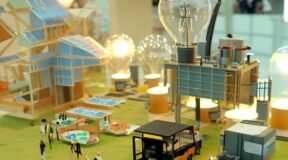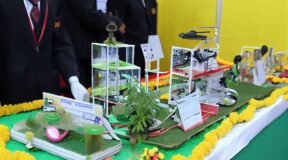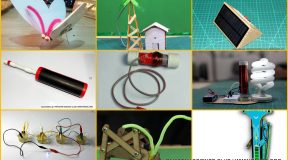This article about hovercraft working and construction of simple hovercraft and its has also video tutorial about its working.
Objective
In this experiment you will test if different volumes of air will cause a balloon powered hovercraft to travel for longer periods of time.
Introduction
A hovercraft is a vehicle that glides over a smooth surface by hovering upon an air cushion. Because of this, a hovercraft is also called an Air-Cushion Vehicle or ACV. The hovercraft creates vents of air, which are trapped beneath the vehicle by a curtain surrounding the base. These currents of air can create an air cushion on any smooth surface, land or water! Since a hovercraft can travel upon the surface of water, it is also called an amphibious vehicle. Here is a picture of a modern hovercraft and a diagram showing how the air vents create the air cushion (Wikipedia, 2007):

| This image shows a modern style hovercraft which carries passengers over the surface of the water. (Wikipedia, 2007) | This image shows how the air vents moving through the hovercraft create the air cushion below the craft for movement: 1) propellers, 2) air currents, 3) fan, and 4) flexible skirt. (Wikipedia, 2007) |
How does the air cushion beneath the hovercraft allow the vehicle to glide to freely? The key to the ease of movement is reducing friction. Vents of slowly moving, low-pressure air are ejected downwards against the surface close below it creating the air cushion. The air is trapped beneath the hovercraft by a flexible skirt, also called the curtain. The trapped air cushion greatly reduces the friction of the vehicle, allowing it to glide freely upon the smooth surface below.
In this experiment, you will build your own mini hovercraft using a CD, recycled bottle, and a balloon. You will use balloons of different sizes to test if more air will cause the hovercraft to travel for longer periods of time. A large balloon will provide a larger volume of air, and a small balloon will provide a smaller volume of air. Will a larger balloon make the hovercraft travel longer than a smaller balloon?
Terms, Concepts and Questions to Start Background Research
To do this type of experiment you should know what the following terms mean. Have an adult help you search the Internet, or take you to your local library to find out more!
- Hovercraft
- Friction
- Air cushion
- Volume
Questions
- How does a hovercraft work?
- How does the flow of air reduce friction of the hovercraft in motion?
- Is the volume of air in a balloon powered hovercraft important for how long it can hover?
Bibliography
- Read this Wikipedia article to understand how a hovercraft works:
Wikipedia contributors, 2007. "Hovercraft," Wikipedia, The Free Encyclopedia [accessed October 6, 2007] http://en.wikipedia.org/w/index.php?title=Hovercraft&oldid=164570589 - There are many designs for balloon hovercrafts, here are three design sources for this project:
- Questacon, 2007. "CD Balloon Hovercraft," Questacon, The National Science and Technology Centre: Canberra, Australia. [accessed October 6, 2007]
http://www.questacon.edu.au/html/squad_activities/forces_cd_hovercraft.html - CUED, n.d. "Balloon Hovercraft," Cambridge University Engineering Department (CUED), UK. [accessed October 6, 2007] http://www.eng.cam.ac.uk/outreach/CUEDresources/HoverMagic/instructions_balloons.pdf
- MAKE, 2006. "Balloon Hovercrafts: Made!" MAKE Magazine. [accessed October 6, 2007] http://www.makezine.com/blog/archive/2006/10/balloon_hovercr.html
- Questacon, 2007. "CD Balloon Hovercraft," Questacon, The National Science and Technology Centre: Canberra, Australia. [accessed October 6, 2007]
- Ready to scale up? Here are two designs for building a large hovercraft you can ride on:
- Beaty, Bill, 1997. "Science Fair Project: Ultra-Simple Hovercraft can lift several adults!" Science Hobbyist: Seattle, WA. [accessed October 6, 2007] http://amasci.com/amateur/hovercft.html
- Twofoos.com, 2005. "The DIY Hovercraft," Twofoos.com [accessed October 6, 2007] http://www.twofoos.com/hacks/hovercraft.html
Make a Hovercraft
Materials and Equipment
- Pop-top cap from a recycled plastic drinking bottle
- An old CD
- Craft glue
- Balloons of different sizes (small, medium, and large)
- Balloon pump (optional)
- Stopwatch
- Large flat surface for testing the hovercraft
Experimental Procedure
- First you will construct the base of the hovercraft, so gather your supplies and prepare a craft space.
- Remove a pop-up lid from a plastic drinking bottle.
- Close the pop-top lid so that air cannot escape, and glue the base so the lid covers the hole in the center of the CD.
- Allow the glue to dry completely. (Optional: You can make several of these if you like.)
- Your complete design (with balloon attached) will look like this (Questacon, 2007):
- Next you will test the hovercraft with your balloons of different sizes. Choose a very small balloon, a medium-sized balloon, and a large balloon for this part of the experiment
- Blow up a balloon and pinch the neck so that no air can escape.
- Stretch the neck of the balloon over the pop-top.
- Place the CD hovercraft on a flat surface and prepare your timer.
- Start your timer, open the pop top lid, and push the hovercraft. Stop the timer when the hovercraft stops hovering.
- For each balloon you should do at least five timed trials. Record the time in seconds (s) for each trial in a data table:
Trial Small Balloon Medium Balloon Large Balloon #1 #2 #3 #4 #5 TOTAL AVERAGE - Calculate the average hover time in seconds for each sized balloon. Do this calculation by adding together the times of all five trials, and then dividing your answer by five.
- Make a graph of your data. Make a scale of the "Average Hover Time in Seconds (s)" on the left side (y-axis) of the graph. Draw a bar for each balloon size up to the corresponding value, and be sure to label your columns.
- Analyze your data and make your conclusions. Did you notice any trends? Which hovercraft hovered for the longest period of time? Why do you think this happened?
Variations
You can also measure the volume of air inside each balloon to have a more quantitative test of the hovercraft. You can measure the volume of air in the balloon two ways:
-
- Water displacement method - Dunk the filled balloon in a large metric measuring container . Subtract the initial water height from the final water height, and the answer will be equal to the volume of the balloon.
- Air displacement method - Fill a large graduated cylinder with water in a large tub of water. Turn the cylinder bottom up and lift so that you can see the measurements, but keeping the opening of the cylinder under water so that the water will not escape. Place the pinched opening of the balloon near the opening of the cylinder and release the balloon so that the air travels up into the cylinder. When the balloon is finished draining air, record the volume of air trapped in the cylinder.
- Geometric method (gives an estimate) - You can measure the circumference of the balloon, and estimate the volume of the balloon based on the formula for the volume of a sphere.
- Try testing the hovercraft on different surfaces. Which type of surface works best?
- What other hovercraft designs can you try? Can you scale up this design to make a larger hovercraft? Can you use the action of a hovercraft for any practical purpose, or to solve a problem?
- For more science project ideas in this area of science, see Aerodynamics & Hydrodynamics Project Ideas.
Watch Video





